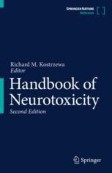Search
Search Results
-
Deep brain implantable microelectrode arrays for detection and functional localization of the subthalamic nucleus in rats with Parkinson’s disease
The subthalamic nucleus (STN) is considered the best target for deep brain stimulation treatments of Parkinson’s disease (PD). It is difficult to...

-
Anthraquinone from Edible Fungi Pleurotus ostreatus Protects Human SH-SY5Y Neuroblastoma Cells Against 6-Hydroxydopamine-Induced Cell Death—Preclinical Validation of Gene Knockout Possibilities of PARK7, PINK1, and SNCA1 Using CRISPR SpCas9
Parkinson’s disease (PD) results from the degeneration of the nervous tissue brought about by ecological and hereditary components which affects...

-
Absence of sympathetic innervation hampers the generation of tertiary lymphoid structures upon acute lung inflammation
Tertiary lymphoid structures (TLS) are lymphoid organs present in inflammatory non-lymphoid tissues. Studies have linked TLS to favorable outcomes...

-
Biomarkers of Neurotoxicity Inform Mechanisms of Vulnerability and Resilience in Dopaminergic Neurons
Vulnerable pathways and associated stress biomarkers characteristic of neurons may be used to identify the chemical triggers for neurodegenerative...
-
Investigation of non-invasive focused ultrasound efficacy on depressive-like behavior in hemiparkinsonian rats
Depression is a common non-motor symptom in Parkinson’s disease (PD) that includes anhedonia and impacts quality of life but is not effectively...

-
Protective effects of 6,7,4′-trihydroxyisoflavone, a major metabolite of daidzein, on 6-hydroxydopamine-induced neuronal cell death in SH-SY5Y human neuroblastoma cells
Daidzein, one of the important isoflavones, is extensively metabolized in the human body following consumption. In particular,...

-
[3H]-NFPS binding to the glycine transporter 1 in the hemi-parkinsonian rat brain
L-3,4-dihydroxyphenylalanine (L-DOPA) is the main treatment for Parkinson’s disease (PD) but with long term administration, motor complications such...

-
Acute Effect of Selective Chemical Inactivation of Sympathetic or Parasympathetic Atrial Ganglionated Plexus Structures on Atrial Fibrillation Inducibility in Pigs
We studied the role of both parts of the autonomic intracardiac nervous system in the pathogenesis of atrial fibrillation (AF). In 12 pigs weighing...
-
6-Hydroxydopa: A Precursor-Neurotoxin with Relative Selectivity for Noradrenergic Neurons
The selective neurotoxin 6-hydroxydopa (6-OHDOPA) was developed because of the correct assumption that it could, with some advantage, replicate...
-
Immunohistochemical Assessment of the Compensatory Responses in Rat Olfactory Bulbs after 6-Hydroxydopamine-Induced Lesion of the Substantia Nigra
We assessed changes of olfactory bulbs in rata with 6-hydroxydopamine destruction of the substantia nigra. The expression of marker proteins of...
-
COA-Cl Evokes Protective Responses Against H2O2-and 6-OHDA-Induced Toxic Injury in PC12 Cells
COA-Cl, a novel adenosine-like nucleic acid analog, has recently been shown to exert neuroprotective effects and to increase dopamine levels both in...

-
A new multigene HCIQ subfamily from the sea anemone Heteractis crispa encodes Kunitz-peptides exhibiting neuroprotective activity against 6-hydroxydopamine
The Kunitz/BPTI-type peptides are ubiquitous in numerous organisms including marine venomous animals. The peptides demonstrate various biological...

-
Potential Therapeutic Effects of Policosanol from Insect Wax on Caenorhabditis elegans Models of Parkinson’s Disease
Parkinson's disease (PD) is the second most common neurodegenerative disease worldwide. The standard treatments for PD focus on symptom relief rather...

-
Neuroprotective effects of polyacrylic acid (PAA) conjugated cerium oxide against hydrogen peroxide- and 6-OHDA-induced SH-SY5Y cell damage
Cerium oxide nanoparticles have been widely investigated against neurodegenerative diseases due to their antioxidant properties that aid in quenching...

-
Classical Model of 6-Hydroxydopamine-Induced Parkinsonism in Rats Is Characterized by Unilateral Lesion of Brain Mesolimbic System
Abstract —Localizing lesions in the brain of rodents after administration of neurotoxic 6-hydroxidopamine (6-OHDA) is important for understanding the...

-
Chronic high-sugar diet in adulthood protects Caenorhabditis elegans from 6-OHDA-induced dopaminergic neurodegeneration
BackgroundDiets high in saturated fat and sugar, termed “Western diets,” have been associated with several negative health outcomes, including...

-
Afobazole Restores the Dopamine Level in a 6-Hydroxydopamine Model of Parkinson’s Disease
In this study, 5 µg of 6-hydroxydopamine (6-OHDA) were injected unilaterally into the striatum of mice. The mice were then treated intraperitoneally...
-
Neuroprotective Effect of Sterculia setigera Leaves Hydroethanolic Extract
Plants are a valuable source of information for pharmacological research and new drug discovery. The present study aimed to evaluate the...

-
Targeted repositioning identifies drugs that increase fibroblast growth factor 20 production and protect against 6-hydroxydopamine-induced nigral cell loss in rats
Endogenous fibroblast growth factor 20 (FGF20) supports maintenance of dopaminergic neurones within the nigrostriatal pathway. Moreover, direct...

-
Synthesis, Anti-inflammatory, and Neuroprotective Activity of N-Substituted Phthalimide Derivatives
AbstractA new series of N -substituted phthalimide compounds was synthesized in good yield. All the compounds were characterized by spectroscopic...

